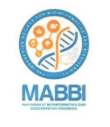Identification of Entomopathogenic Nematode-Associated Bacteria Originating from Mojokerto
Abstract
Entomopathogenic nematodes (EPN) are one of the soil worms that have been widely used as a natural pest control. EPN has its pathogenic capability because of the mutualistic interactions between nematodes and symbiotic bacteria inside the digestive tract of nematodes. Symbiotic bacteria capable of producing exoenzymes that are toxic to insects. The isolation of symbiotic bacteria accomplished by infection of obtained EPN (Belik II isolate) into Tenebrio molitor larvae. Symbiotic bacteria were isolated from the hemolymph of dead larvae on NBTA media. Isolation of symbiotic bacteria was successfully obtained two morphologically distinct bacteria: B 3.1 isolate and B 4 isolate. Both bacteria were further identified using PCR analysis of the 16S rRNA gene. Based on the sequencing results, the B 3.1 isolate was in accordance with Acinetobacter pittii strain ATCC 19004, while B 4 isolate was in accordance with bacteria Enterobacter aerogenes strain KCTC 2190. The characterization of B 3.1 isolate was shown to have similarities with Acinetobacter sp., i.e.: gram-negative, non - motile, rod-shaped, and some other characteristics of biochemical tests. While the characterization of B 4 isolate was shown to have similarities with E. aerogenes i.e.: gram-negative, rod-shaped, motile, and some other characteristics of biochemical tests. These findings will be the potential to be applied as biological agents in pest control.
Full Text:
PDFDOI: https://doi.org/10.47007/ijobb.v5i1.76
Refbacks
- There are currently no refbacks.
| Indonesian Journal of Biotechnology and Biodiversity Published by: Publishing Department of Esa Unggul University Arjuna Utara No 9 Street Kebon Jeruk Jakarta - 11510 Indonesia | |








.png)

